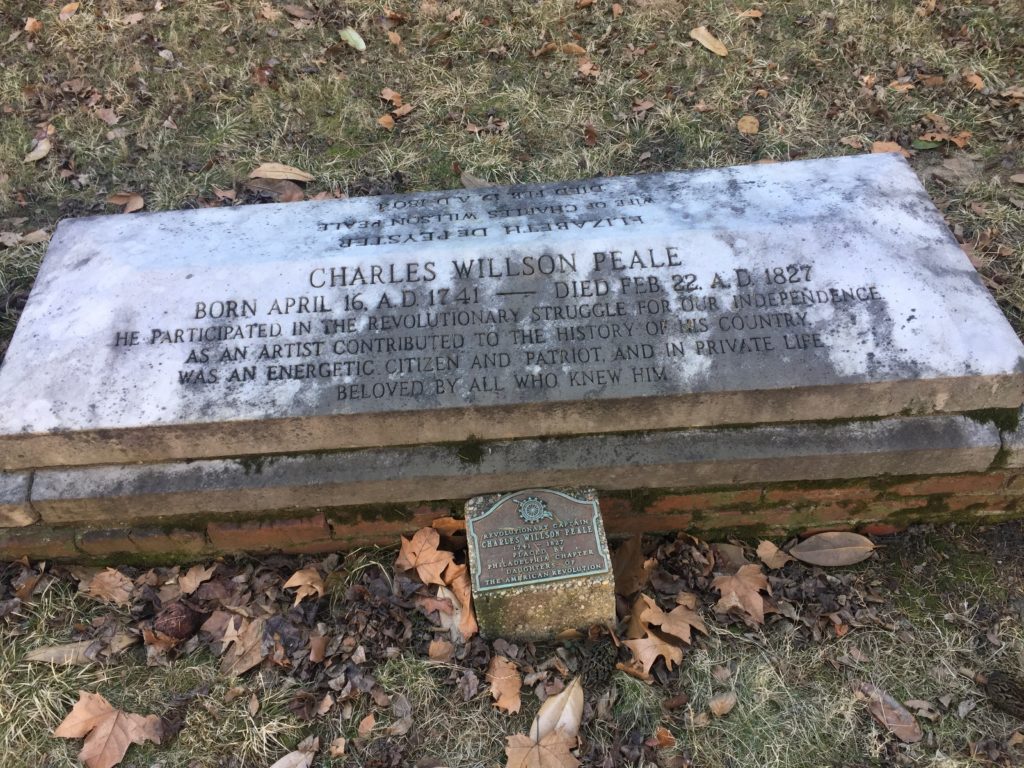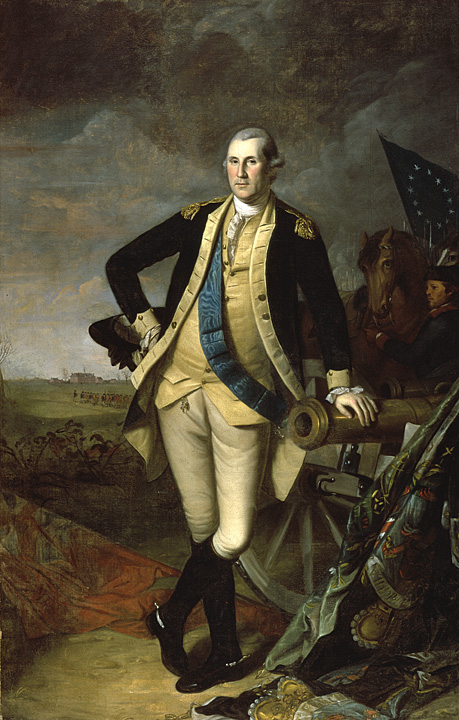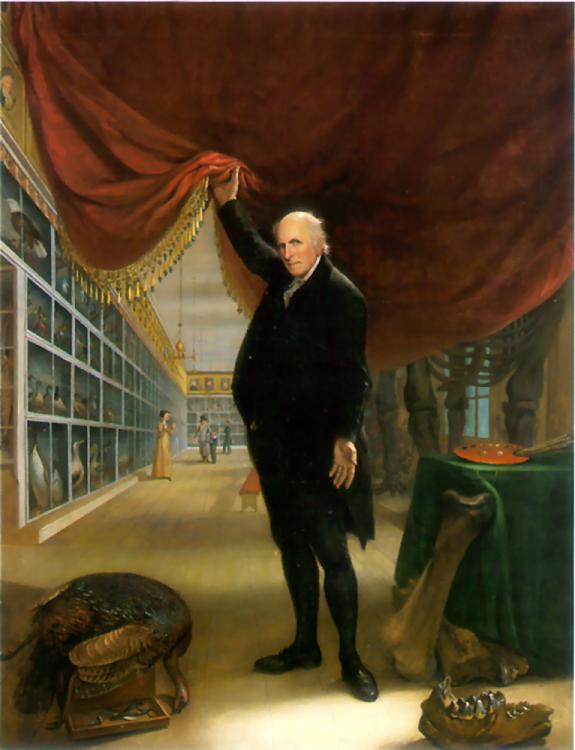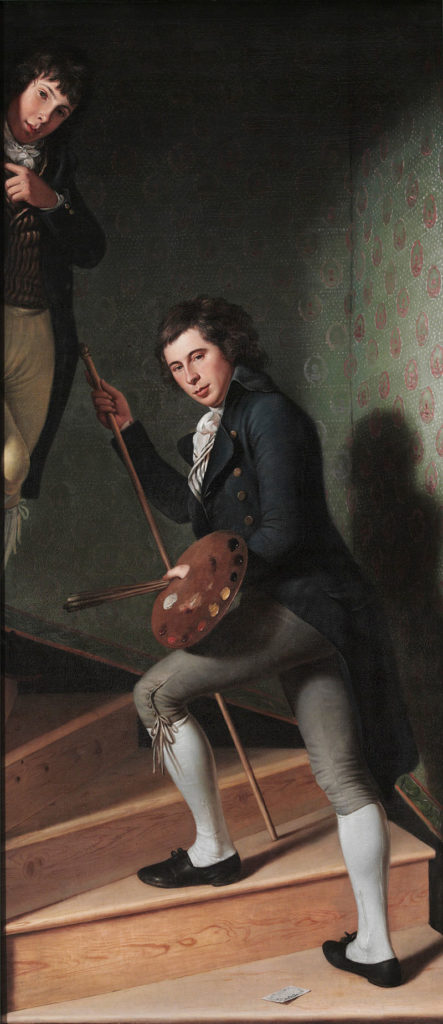Erik Visits an American Grave, Part 648
This is the grave of Charles Willson Peale.

Born in 1741 in Queen Anne’s County in Maryland, Peale grew up in middling circumstances. He was apprenticed to a saddle maker when he was 14 but was not very good at it. He opened his own saddle shop as a young adult but it failed. Meanwhile, he became interested in the politics of the day, joining the Sons of Liberty in the 1760s. After he failed at saddle making, he tried his hand at other artisan-based professions, such as metalworking and clocks, but couldn’t make a living at those either. Next, he decided to take up painting. This was a good decision.
Peale very quickly showed great promise as a portrait painter, which was both artistically and financially in vogue for artists of the British world in the late 18th century. He won some early commissions and studied under some of the better artists in the colonies. This allowed him to go England in 1767 to study under Benjamin West. He remained there until 1770. He then moved to Annapolis, Maryland, and successfully pried his trade there.
Peale was a firm supporter of the Patriot cause and when the American Revolution broke out, he went to Philadelphia to offer his services to the men who became known as the Founding Fathers. He also joined the Pennsylvania militia in 1776 and fought in several battles, including at Trenton and Princeton, being mustered out at the rank of captain. He served in the Pennsylvania legislature in 1779-80 and then went back to painting full time.
Peale became a favorite of George Washington. While Gilbert Stuart has become the most famous portrait painter of the Founders, due in part to his portrait of Washington being chosen for the $1 bill, Peale was equally well known. Washington first sat for him in 1772 and Peale painted him a total of seven times. He painted many other Founders, as well as on many other topics. He painted about 1,100 portraits over his life, including not only Washington, but John Adams, Benjamin Franklin, Thomas Jefferson, William Clark, and many other leading figures of the Early Republic.
Peale also became a leading benefactor of early American science. He founded the Philadelphia Museum in 1786 to collect artifacts and specimens, especially birds that he stuffed himself. This was the first major scientific museum in the United States. It was the first museum to display a mastodon skeleton after Peale found one while tramping around New York. He and his son mounted it themselves. Thomas Jefferson used this mastodon skeleton to argue with Europeans that the U.S. was a superior place, as there was an active debate over which region was premier based around the height of people and the size of animals. These sorts of debates were the origin of the scientific racism that became prominent by the late 19th century. Jefferson believed that mastodons still roamed deeper into the continent and for him, Peale’s mastodon was evidence of that and of American superiority. He moved the museum to Baltimore in 1812 and his son Rubens ran it from this point forward. After Peale’s death, the museum failed and P.T. Barnum ended up buying a bunch of it for his show.
Peale was very active in the bedroom. He outlived three wives, The first bore him 10 children and the second four more. Many of those children were prominent on their own, especially his son the painter Rembrandt Peale. Unfortunately, Peale was also a slaveowner for at least part of his life and he did train at least one slave in painting.
Peale was an interesting guy all the way around. He bought the patent rights to the polygraph from John Isaac Hawkins, who invented it. He wrote books on everything from carpentry to mental health. He taught dancing lessons from the time he was a young man. He even toyed around with dentistry, which reminds me of why I am glad I don’t live in the late 18th century. He was an Enlightenment man and he knew it. His last great masterpiece was 1822’s The Artist In His Museum, where he shows us behind the curtain of the scientific man of the early 19th century.
Peale died in 1827, at the age of 85.
Let’s look at some of Peale’s work.




Charles Willson Peale is buried in Saint Peter’s Episcopal Courtyard, Philadelphia, Pennsylvania. His second wife, Elizabeth, is buried with him.
This grave visit was funded by LGM reader contributions. In fact, this Philadelphia trip, taken in mid-February, was the last grave-funded trip of the Before Times. Eventually, these times will end and I will be able to continue the internet’s least important series. If you would like this series to visit other early American artists, you can donate to cover the required expenses here. Washington Allston is buried in Cambridge and Ralph Earl is in Boston, Connecticut. Previous posts in this series are archived here.
